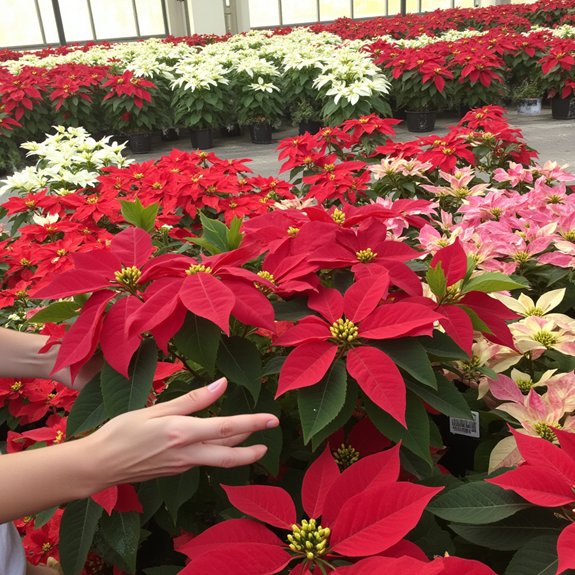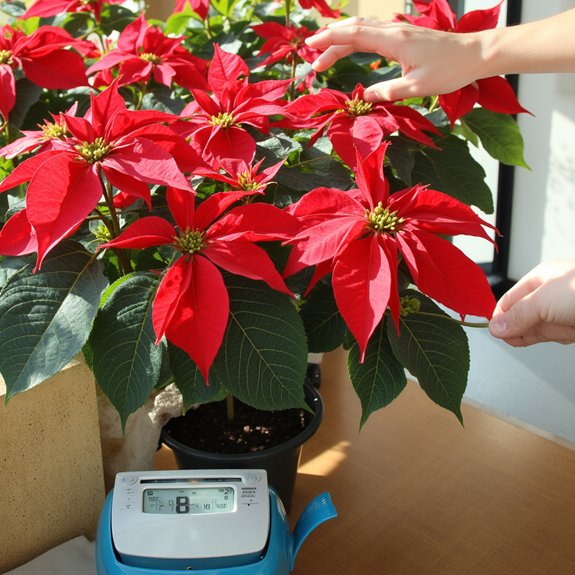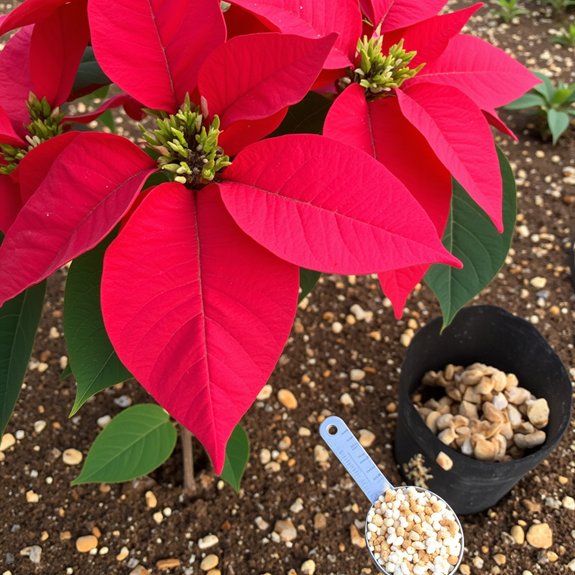You’ve probably watched a beautiful poinsettia turn into a sad, wilted mess within weeks of bringing it home. The truth is, these vibrant holiday plants aren’t actually difficult to care for—most people just make three critical mistakes that doom their poinsettia from day one. Once you understand what your plant truly needs and avoid these common pitfalls, you’ll discover the simple secrets that keep those colorful bracts looking stunning for months, not days.
Contents
- 1 Selecting and Bringing Home Your Poinsettia
- 2 Setting Up the Perfect Growing Environment
- 3 Mastering Watering and Humidity Requirements
- 4 Temperature and Light Management
- 5 Fertilizing Guidelines During Bloom Season
- 6 Identifying and Treating Common Problems
- 7 Extending Your Plant’s Life Beyond the Holidays
Selecting and Bringing Home Your Poinsettia

When you’re selecting a poinsettia at the store, you’ll want to inspect it like you’re choosing the best apple from the bunch. For proper poinsettia selection, look for cyathia in bud stage, vibrant bracts, and green leaves extending down the stem. Check that soil feels evenly moist, not soggy or bone-dry. Avoid plants near drafty doors or heat sources.
Transportation tips are essential once you’ve made your choice. Don’t leave your poinsettia in a cold car, as temperature swings cause wilting and leaf drop. Cover the plant with a bag or jacket during cold weather, and head straight home after purchase.
Setting Up the Perfect Growing Environment
Once you’ve brought your poinsettia home safely, creating the right environment becomes your next priority. Start with proper soil selection—choose well-draining, all-purpose potting mix combined with perlite for ideal drainage. Your potting techniques matter considerably; select containers with adequate drainage holes and remove decorative foil sleeves that restrict airflow. Position your plant near South-West or East-facing windows for 6-8 hours of bright, indirect sunlight daily. Maintain stable temperatures between 65-75℉, avoiding drafts and heat sources. Keep humidity levels at 55%-75% by grouping plants together or using a humidifier for best results.
Mastering Watering and Humidity Requirements

While your poinsettia’s environment sets the foundation for success, proper watering techniques will make or break your plant’s health. Check soil moisture by inserting your finger two inches deep—water only when it’s dry at this level.
When watering, take your plant to the sink and saturate thoroughly with lukewarm water. Let excess drain completely before returning it to its spot.
Humidity levels between 55-75% keep poinsettias thriving. Group plants together or use a humidifier to boost moisture. Mist occasionally, but don’t let water sit on leaves to prevent disease issues.
Temperature and Light Management
The perfect temperature zone for your poinsettia sits between 65-75°F, and maintaining this range will keep those colorful bracts vibrant for weeks. Temperature fluctuations can cause rapid leaf drop, so keep your plant away from heating vents, fireplaces, and frequently opened doors.
Position your poinsettia near a South-West or East-facing window for ideal light exposure. You’ll need 6-8 hours of bright, indirect sunlight daily to prevent drooping. Don’t let leaves touch cold windowpanes, as this creates damaging temperature swings that’ll stress your plant and shorten its display life considerably.
Fertilizing Guidelines During Bloom Season

Skip the fertilizer completely during bloom season. Your poinsettia doesn’t need extra nutrients right now, since it’s already displaying those gorgeous colored bracts. Different fertilizer types can actually harm your plant during this period, causing bract-edge burn that’ll ruin the display you’re trying to maintain.
The soil likely contains slow-release fertilizer that’ll handle bloom nutrition needs throughout winter. Adding more creates nutrient overload, which stresses the plant unnecessarily.
Save fertilizing for spring if you’re keeping your poinsettia year-round. Right now, focus on proper watering, lighting, and temperature instead.
Identifying and Treating Common Problems
Even when you’re following proper care guidelines, poinsettias can develop issues that need quick attention. Pest identification starts with checking leaves for sticky residue, tiny insects, or discoloration. Common culprits include aphids and whiteflies, which you can treat with insecticidal soap or neem oil. For wilting solutions, first check soil moisture using the knuckle test. If soil’s dry, water deeply with lukewarm water. If soil’s soggy, reduce watering frequency and guarantee proper drainage. Temperature fluctuations also cause wilting, so verify your plant isn’t near drafts or heat sources that stress the foliage.
Extending Your Plant’s Life Beyond the Holidays
While most people discard their poinsettias after New Year’s, you can keep yours thriving year-round with proper post-holiday care. Start your post holiday maintenance by gradually reducing watering as bracts fade and fall. In late March, prune stems back to 4-6 inches above soil level to encourage new growth.
Make seasonal adjustments by moving your plant outdoors once nighttime temperatures stay above 50°F. Continue pruning new growth through July to maintain bushiness. By September, bring it inside and provide 14 hours of darkness daily for 8-10 weeks to trigger colorful bract development for next year’s display.
